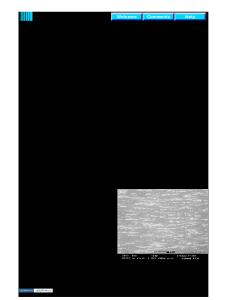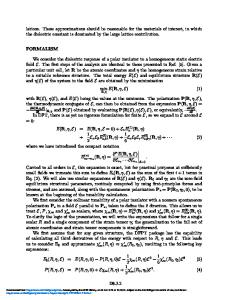High Dielectric Constant Polymer Ceramic Composites
- PDF / 358,267 Bytes
- 6 Pages / 420.48 x 639 pts Page_size
- 5 Downloads / 416 Views
ABSTRACT A new polymer-ceramic composite, using the newly developed relaxor ferroelectric polymer that has a high room temperature dielectric constant as the matrix, is reported. Different kinds of ceramic powders were studied and homogeneous composite thin films (20gtm) were fabricated. It was observed that the increase of the dielectric constant of the composites with the ceramic content could be described quite well by the expression developed by Yamada et al., when the ceramic content is below 60% by volume. The experimental data shows that the relative dielectric constant of composites using PMN-PT powders can reach more than 250 with weak temperature dependence (i.e., the dielectric constant changes little in a broad temperature range). In addition to high permittivity, the composite prepared in clean environment also has high breakdown field strength (120MV/m), which yields an energy storage density more than 14J/cm 3 . The dielectric behavior of the composite at various frequencies was also studied and the results show that the material is promising for high frequency applications.
INTRODUCTION Ferroelectric ceramics, such as barium titanate (BaTiO3), with very high dielectric constants, are widely used in the applications of capacitors and high-density energy storage devices. However, the fragility, inflexibility and poor processibility, which are inherent to ceramics, limit their applications. Using polymers to replace ceramics has been the focus of many studies in the past several decades, since they are flexible, easy to process and possess higher breakdown strength. But their dielectric constants are very low. Currently, the polymeric capacitors, which account for nearly half of the market, are made from polystyrene, polypropylene, polyester and polycarbonate. None of them has a dielectric constant higher than 10. For applications of capacitors and energy storage devices, it is highly desirable to develop polymer-based materials with high dielectric constant to achieve high volume efficiency and energy storage density. In past twenty years, there has been a great interest in the development of polymer ceramic composites with high dielectric constant [1,2]. However, due to the low dielectric constant of polymer matrix, the relative dielectric constants of the ceramic powder-polymer composites (0-3 composites) developed up to date can only reach about 60 [3,4,5]. It is clear that the dielectric constant of a composite is determined by the dielectric constants of its polymer and ceramic components and their volume percentages [6,7] and past experimental results indicate that the main limitation to the high dielectric constant composite is the low dielectric constant of the polymer matrix. A recent research on P(VDF-TrFE) copolymer found that electron irradiation with proper dosage can increase its dielectric constant up to 50 with a broad peak [8]. In addition, it is well known that relaxor ferroelectric material PMN-PT has much higher dielectric constant compared with traditional ferroelectric materials
Data Loading...











